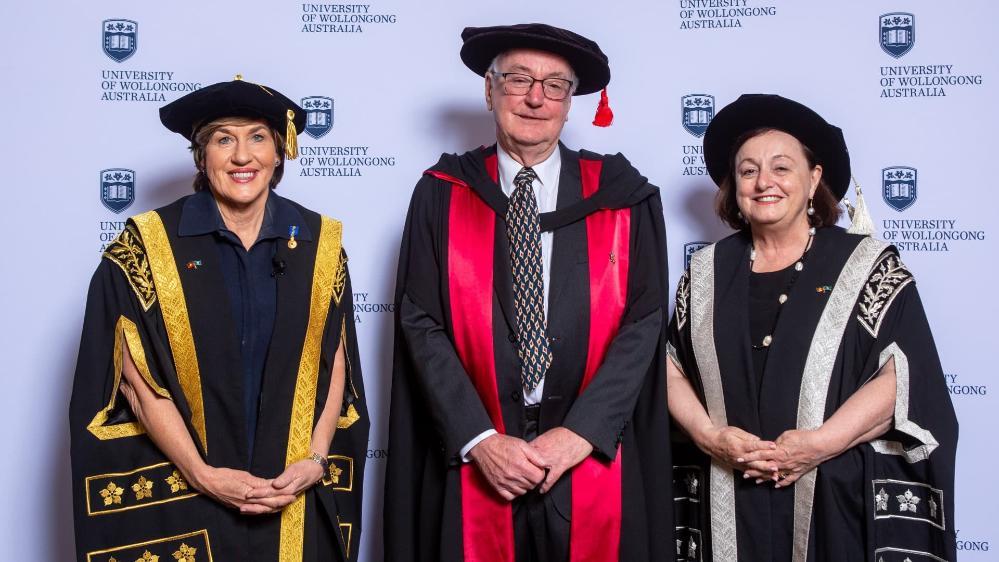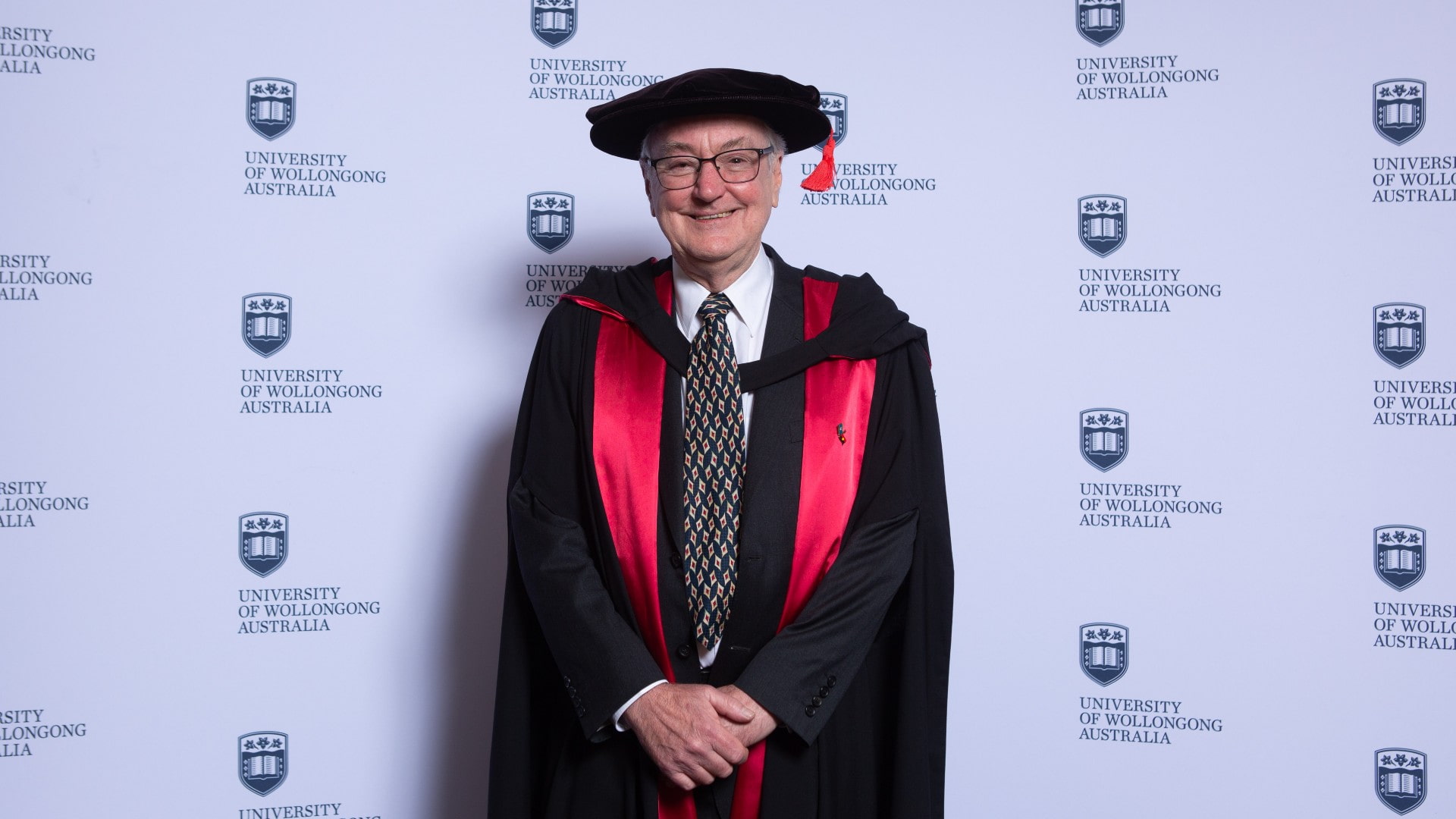November 6, 2023
Renowned biochemist receives Emeritus Professor
Academic leader Professor Nicholas Dixon helping to nurture the next generation of UOW researchers
Professor Nicholas Dixon credits his success to being in the right place at the right time.
From his early childhood, he was always interested in the biology of how things worked, and it is a passion for discovery that has only grown over the more than 50 years he has been involved in ground-breaking research.
“As a kid, I was very interested in research and when a family friend gave me a pile of Scientific American magazines to read when I was about 10 years old, I realised this was what I actually wanted to do - scientific research,” he said.
“I didn’t know what it was of course. I did well in my school exams but when I left school, I didn’t know how to do research or how to get into it as a career.”
Professor Dixon decided to enrol in a medicine degree, thinking he may be able to use it as a stepping stone into medical research.
“I never wanted to be a GP,” he said. “But because I didn’t know how to become a medical researcher, I thought this was the only option.”
After the first year of the medical degree, Professor Dixon said he realised there was an easier way to achieve his goal.
He left medicine and enrolled in a Bachelor of Science at the University of Queensland.
After completing that he did an Honours degree in 1973 followed immediately by a PhD, which he completed in 1977.
“Things went linearly for me,” he said.
It was while doing his PhD that Professor Dixon’s career really took shape when he made a discovery that had international impacts.
“Things were a lot different in the 1970s than they are now,” he said. “We had written Honours exams that went for two days, and the topic was any aspect of biochemistry.
“In those days students were expected to have a broad knowledge of all the sciences and I was fascinated by biochemistry.
“I was lucky enough to do my Honours and PhD with a professor at the University of Queensland who was a brilliant scientist and a hard taskmaster in terms of precision and accuracy.
“I learned a lot from him.”
Professor Dixon was fascinated by how life worked from a biochemical point of view, realising the human body doesn’t work through magic but obeys the laws of chemistry.
During his PhD, Professor Dixon discovered the first example – and still one of only two - of a natural enzyme that uses nickel to catalyse its chemical reaction.
“The clue to this discovery was that this enzyme is light green in colour, and no-one else had ever noticed this,” he said.
“I was lucky that in my PhD I made a discovery that was pretty significant – how enzymes work – working on one of the most efficient enzymes that make a chemical reaction go billions of times faster.
“My supervisor was fascinated by how this chemistry could work. He set me to task to try to discover that.
“This one I was studying was green and the question was to find out why it was green.
“I used all the analytical tools that were available and found that it contained nickel.
“No-one had ever discovered a nickel enzyme before. I then had to find out why it contained nickel and no other metallic elements that occur in nature - that was a big discovery at the time.”
The discovery led to 10 first-author papers from his PhD and several independently funded fellowships over many years.
“Having my own funding allowed me to work with Nobel Laureate Arthur Kornberg at Stanford at a time when recombinant DNA methods were being invented at Stanford and nearby,” he said.
“I was introduced to the field of bacterial DNA replication mechanisms while working with Dr Kornberg.
“With some short diversions along the way, this subject has remained the primary focus of my research ever since I began my first independent research program as a single-person research group in 1983.
“During this time, my research transitioned from working on the individual proteins to studies of how they interact with each other and assemble into the dynamic multiprotein machine called the replisome.
“Our focus has transitioned to using the replisome as a model system to understand the basic chemical design principles that enable the functions of all of nature’s dynamic machines, and we are now at the stage where we can articulate all of these principles.”

Chancellor Christine McLoughlin, Professor Nicholas Dixon and Vice-Chancellor Professor Patricia M Davidson.
His work at Stanford between 1981-1983 led to his appointment to a research group leader position at Australian National University (ANU) in 1986.
It was the first appointment of a biological chemist to a faculty position in a chemistry school in any Australian university.
Professor Dixon said at that time ANU was still block-funded for research, which enabled him to dedicate a decade to the development of a broad multidisciplinary research program without having to depend on winning research grants.
“That paid off when ANU researchers were allowed to apply for Australian Research Council and National Health and Medical Research Council funding from 2002,” he says.
“I was immediately successful, and my research has been continuously and generously funded by major research grants from ARC and, to a lesser extent, from NHMRC ever since.”
During his tenure at ANU, he led the development of the multidisciplinary Centre for Molecular Structure and Function across three research schools and guided the development of the Biological Chemistry section of the Research School of Chemistry.
He continued his relationship with ANU until 2013, and in 2006 was also appointed to the University of Wollongong (UOW) to lead the development of interdisciplinary research across the chemistry-biology interface, which led to the establishment of the Centre for Medical and Molecular Bioscience (CMMB).
“Under my leadership and that of my colleagues, the CMMB became one of UOW's most successful and visionary research strengths,” he said.
“This ultimately led to its transformation to become the Molecular Horizons Institute in 2019, under the leadership of Professor Antoine van Oijen.
“Over a five-year period, Professor van Oijen and I were academic leaders of the construction of the state-of-the-art Paul Wellings Building, occupied from 2020.”
Professor Dixon said the honour of receiving an Emeritus Professorship is humbling.
“The collegiality of UOW staff at all levels has enabled me to achieve my vision to establish a world-class research centre in biomedical sciences here, and I am grateful for that opportunity and their continued support,” he said.
“Although the achievements of research scientists are usually measured by their contributions to knowledge and technological developments, those who work in universities serve another equally important function.
“That function is to nurture, guide, mentor and teach the following generations of scientists which the Emeritus Professorship will allow me to continue doing.
“Ultimately, my most important contributions to UOW will be seen to be my achievements in mentoring and training, teaching next generations to be fearless in tackling important and difficult research problems in a collegial manner.”
